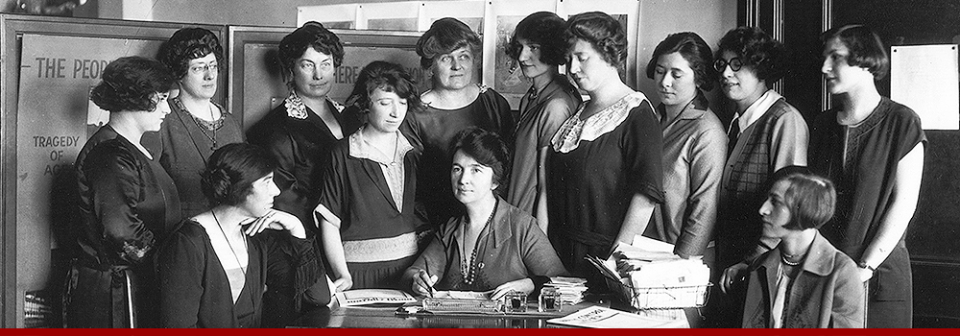Deformity. Infection. Torture. Desperation.
Sounds like the tag line to a new gore-filled horror flick, right? Well, maybe. But in this case, I’m talking about the content of Margaret Sanger’s Motherhood in Bondage, a collection of 470 letters received from women (and even some men!) struggling with the burden of childbirth. At a glance, that doesn’t sound too scary, but these texts contain more nightmare material than the entire Friday the 13th series combined.
In honor of its original October 1928 publication, I figured I’d take time this month to read Sanger’s third book release. I was shocked by how gripping it was! Throughout the 1920’s, Sanger received over 250,000 letters filled with questions and pleas for help from families without access to proper birth control. Motherhood is a compilation of only a fraction of these letters, showcasing some of the most horrible scenarios imaginable. Locations are unknown, and each letter is kept anonymous, creating a feeling that “this could be anyone.” Watch out, Halloween: your demons and ghosts are no match for the horror found within reality.
The letters are grouped into sixteen chapters based on theme. Some cover particular age and income groups, while others contain stories of failed attempts at contraception. With chapter titles like “The Struggle of the Unfit” and “The Trap of Maternity,” Sanger means to instill fear. Yet these headings couldn’t prepare me for the misfortune encountered by their numerous authors as they embarked on “a sort of Dantesque pilgrimage through the Inferno of motherhood.” [1]
The first letter of the first chapter, aptly titled “Girl Mothers,” immediately sets the tone of the book. “One month before my thirteenth birthday,” the letter reads, “I became the mother of my first child, and now at the age of thirty I am the mother of eleven children, ten of them living, the youngest now seven years old” [2] The thought of bearing the weight of motherhood at such an age is chilling, and this woman was forced to spend the rest of her young life rearing more children. This quote also suggests child death, a recurring theme in the life of these frequent mothers. I soon learned that many of the women featured in this anthology boasted numbers of children in the double digits, their quality of life declining with each birth.
However, the horror isn’t just in numbers, whether it be age or number of children. Many of the women lament of looking “more dead than alive,” while others complain of hemorrhaging and the development of tumors after multiple childbirths. And the mothers were not the only ones to suffer! A few correspondents share their stories of birth defection, one writing that her daughter was born with three legs and three arms. A living image of horror.
One particularly chilling chapter of the book is “Voices of the Children,” where daughters of large, unhappy homes are doomed to repeat their mothers’ suffering. One unpunctuated and painful quote from letter twelve reads,
When he came back I had three more miscarriages, and two years ago I gave birth to a little girl and four months ago to another little girl and I can’t stand it any longer for I am all dragged out and between washing and sewing and the housework and looking after the children, I have no pleasures. [3]
Occasionally, these women would perform self-abortion, employing drugs or unsterile household items. This doesn’t sound too far off from the plot of a new Saw movie. Most of the authors featured in this compilation came from poverty, and put their own lives in danger just to avoid bringing more children into the world. In a final chapter, Sanger emphasizes the problem with unsympathetic doctors giving no true advice on preventing future pregnancies to suffering mothers.
Each new baby is less welcome than the last. Its chances of surviving the perils of infancy are correspondingly lessened. As the children grow older, the expenses of the family increase and the burden of debt becomes heavier and heavier. [4]
The most terrifying aspect of these letters is the feeling of guilt portrayed by each mother. Though they ask what can be done to prevent more children, they all feel a crushing sense of responsibility towards their inability to provide for their children. The women feel themselves to be “selfish” and “failures,” although their inability to provide is upsetting, they are blaming themselves for things that are to a large degree out of their control.
Did Sanger choose these letters to exploit only extreme scenarios? Were there ways for these women to avoid their misfortune? Both are entirely possible. This does not distract from its message. Although the book was not initially successful, it has proved to be an effective argument for the need for accessible contraception. The book does tend to get a bit repetitive, but this only pushes the demand for sympathy further. As one letter emphasizes,
Birth Control is the salvation of the poor and as the working man and his family is in the majority, that makes for a better country to live in. [5]
In a sense, Motherhood in Bondage functions like a book of scary stories – invoking emotions of fear, disgust, and despair. If nothing else, it reads as a cautionary tale about taking birth control for granted.
This book certainly made a lasting impression on me, just in time for the holiday devoted to treachery. If you’re still in need of a last minute Halloween costume, fret not! Pick up a copy of Motherhood in Bondage… I’m sure it will inspire more than a few ideas.
1. Sanger, Margaret. Motherhood in Bondage. Columbus: Ohio State University Press, 2000, 411.
2. Ibid., 6.
3. Ibid.,191.
4. Ibid., 25.
5. Ibid., 57.








